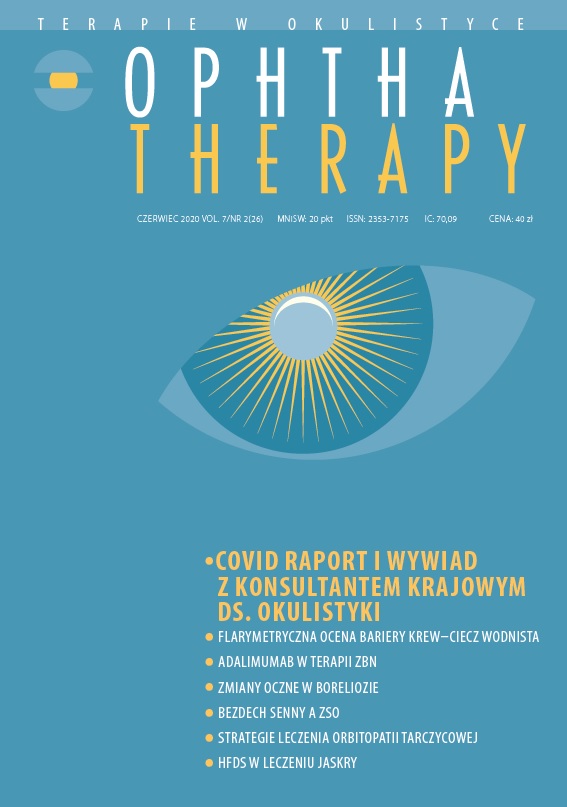Current and novel strategies for the treatment for active thyroid orbitopathy Review article
Main Article Content
Abstract
Graves’ ophthalmopathy is a consequence of an autoimmune orbital reaction that is caused by an antigen or antigens that are common to the thyroid and orbit. This review discusses the pathogenesis of thyroid orbitopathy, current treatment strategies, and new treatment options for both hyperthyroidism and the active phase of ophthalmopathy. The traditional strategy for treating Graves’ ophtalmopathy involves immunosuppressive therapy with steroids, orbital radiation therapy, and surgical decompression. New treatment options include the use of drugs that modulate specific cellular proteins that are involved in orbital autoimmune pathways. These include monoclonal antibodies, cytokine inhibitors, and selective immunosuppressants.
Downloads
Article Details

This work is licensed under a Creative Commons Attribution-NonCommercial-NoDerivatives 4.0 International License.
Copyright: © Medical Education sp. z o.o. License allowing third parties to copy and redistribute the material in any medium or format and to remix, transform, and build upon the material, provided the original work is properly cited and states its license.
Address reprint requests to: Medical Education, Marcin Kuźma (marcin.kuzma@mededu.pl)
References
2. Hiromatsu Y, Eguchi H, Tani J et al. Graves' ophthalmopathy: epidemiology and natural history. Intern Med. 2014; 53: 353-60.
3. Sawicka-Gutaj N, Gutaj P, Sowiński J et al. Influence of cigarette smoking on thyroid gland-an update. Endokrynol Pol. 2014; 65: 54-62. https://doi.org/10.5603/EP.2014.0008.
4. Wiersinga WM. Graves’ ophthalmopathy. Thyroid International 1997; 3: 1-15.
5. Blandford AD, Zhang D, Chundury RV et al. Dysthyroid optic neuropathy: update on pathogenesis, diagnosis, and management. Expert Rev Ophthalmol. 2017; 12: 111-21. https://doi.org/10.1080/17469899.2017.1276444.
6. Heufelder AE, Dutton CM, Sarkar G et al. Detection of TSH receptor mRNA in cultured fibroblasts from patients with Graves’ ophthalmopathy and pretibial dermopathy. Thyroid 1993; 3: 297-300.
7. Wang Y, Smith TJ. Current concepts in the molecular pathogenesis of thyroid-associated ophthalmopathy. Invest Ophthalmol Vis Sci. 2014; 55: 1735-48.
8. Yeatts RP. Graves’ ophthalmopathy. Med Clin North Am. 1995; 79: 195-209.
9. Donaldson SS, Bagshaw MA, Kriss P. Supervoltage orbital radiotherapy for Graves’ ophthalmopathy. J Clin Endocrinol Metab. 1973; 37: 276-85.
10. Mourits MP, Koorneef L, Wiersinga WM et al. Clinical criteria for the assessment of disease activity in Graves’ ophthalmopathy: a novel approach. Br J Ophthalmol. 1989; 73: 639-44.
11. Gerding MN, van der Meer JWC, Broenink M et al. Association of thyrotropin receptor antibodies with the clinical features of Graves’ ophthalmopathy. Clin Endocrinol. 2000; 52: 267-71.
12. Drui D, Du Pasquier Fediaevski L, Vignal Clermont C et al. Graves' orbitopathy: Diagnosis and treatment. Ann Endocrinol (Paris). 2018; 79: 656-64. https://doi.org/10.1016/j.ando.2018.08.005.
13. Ruchała M, Sawicka-Gutaj N. Advances in the pharmacological treatment of Graves' orbitopathy. Expert Rev Clin Pharmacol. 2016; 9: 981-9. https://doi.org/:10.1586/17512433.2016.1165606.
14. Bartalena L, Baldeschi L, Dickinson A et al. European Group on Graves' Orbitopathy (EUGOGO) Consensus statement of the European Group on Graves' orbitopathy (EUGOGO) on management of GO, Eur J Endocrinol. 2008; 158(3): 273-85.
15. Shiber S, Stiebel-Kalish H, Shimon I et al. Glucocorticoid regimens for prevention of Graves' ophthalmopathy progression following radioiodine treatment: systematic review and meta-analysis. Thyroid. 2014; 24: 1515-23. https://doi.org/10.1089/thy.2014.0218.
16. Kotwal A, Stan M. Current and Future Treatments for Graves' Disease and Graves' Ophthalmopathy. Horm Metab Res. 2018; 50: 871-86. https://doi.org/10.1055/a-0739-8134.
17. Miśkiewicz P, Kryczka A, Ambroziak U et al. Is high dose intravenous methylprednisolone pulse therapy in patients with Graves' orbitopathy safe? Endokrynol Pol. 2014; 65(5): 402-13. https://doi.org/10.5603/EP.2014.0056.
18. Zang S, Ponto KA, Kahaly GJ. Clinical review: Intravenous glucocorticoids for Graves' orbitopathy: efficacy and morbidity. J Clin Endocrinol Metab. 2011; 96: 320-32. https://doi.org/10.1210/jc.2010-1962.
19. Bartalena L, Marcocci C, Chiovato L et al. Orbital cobalt irradiation combined with systemic corticosteroids for Graves’ ophthalmopathy: comparision with systemic corticosteroids alone. J Clin Endocrinol Metab. 1983; 56(6): 1139-44.
20. Stan MN, Garrity JA, Bradley EA et al. Randomized, double-blind, placebo-controlled trial of long-acting release octreotide for treatment of Graves' ophthalmopathy. J Clin Endocrinol Metab. 2006; 91: 4817-24.
21. Świerkot M, Kulawik G, Sarnat-Kucharczyk M et al. Long-term remission of steroid-resistant Graves' orbitopathy after administration of anti-thymocyte globulin. Endokrynol Pol. 2020; 71(2): 198-9. https://doi.org/10.5603/EP.a2019.0067.
22. Stan MN, Garrity JA, Carranza Leon BG et al. Randomized controlled trial of rituximab in patients with Graves' orbitopathy. J Clin Endocrinol Metab. 2015; 100(2): 432-41. https://doi.org/10.1210/jc.2014-2572.
23. Salvi M, Vannucchi G, Currò N et al. Efficacy of B-cell targeted therapy with rituximab in patients with active moderate to severe Graves' orbitopathy: a randomized controlled study. J Clin Endocrinol Metab. 2015; 100: 422-31. https://doi.org/10.1210/jc.2014-3014.
24. Pérez-Moreiras JV, Alvarez-López A, Gómez EC. Treatment of active corticosteroid-resistant graves' orbitopathy. Ophthalmic Plast Reconstr Surg. 2014; 30: 162-7. https://doi.org/10.1097/IOP.0000000000000037.
25. Pascual-Camps I, Molina-Pallete R, Bort-Martí MA et al. Tocilizumab as first treatment option in optic neuropathy secondary to Graves' orbitopathy. Orbit. 2018; 37: 450-3. https://doi.org/10.1080/01676830.2018.1435694.
26. Smith TJ, Kahaly GJ, Ezra DG et al. Teprotumumab for Thyroid-Associated Ophthalmopathy. N Engl J Med. 2017; 376: 1748-61. https:// doi.org/10.1056/NEJMoa1614949.
27. Krieger CC, Place RF, Bevilacqua C et al. TSH/IGF-1 Receptor Cross Talk in Graves' Ophthalmopathy Pathogenesis. J Clin Endocrinol Metab. 2016; 101: 2340-7. https://doi.org/10.1210/jc.2016-1315.
28. Paridaens D, van den Bosch WA, van der Loos TL et al. The effect of etanercept on Graves' ophthalmopathy: a pilot study. Eye (Lond). 2005; 19: 1286-9.
29. Ye X, Bo X, Hu X et al. Efficacy and safety of mycophenolate mofetil in patients with active moderate-to-severe Graves' orbitopathy. Clin Endocrinol (Oxf). 2017; 86: 247-55. https://doi.org/10.1111/cen.13170.
30. Kahaly GJ, Riedl M, König J et al. Mycophenolate plus methylprednisolone versus methylprednisolone alone in active, moderate- to-severe Graves' orbitopathy (MINGO): a randomised, observer-masked, multicentre trial. Lancet Diabetes Endocrinol. 2018; 6: 287-98. https://doi.org/10.1016/S2213-8587(18)30020-2.

